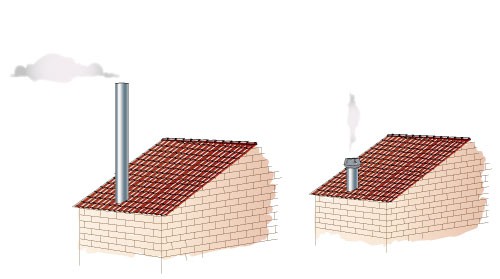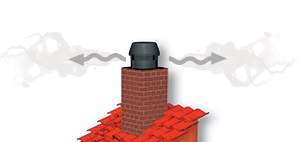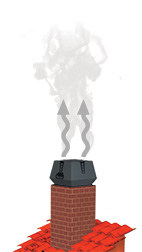We have answers to many frequently asked questions.
Chimney Fans
Facts and technical information
Technical specifications
Facts about chimney fans for solid fuel
Where should they be used? On all chimneys that lack sufficient draught What size of fireplace is covered? From quite small fireplaces and wood burning stoves to industrial installation What is the applicable temperature range? -30 – +80 ºC Where are they installed? On top of the chimney aperture. They can be concealed if you wish What is the weight? The smallest fan for private use weighs approx. 9 kg. The largest weighs more than 30 kg External dimensions in mm: Smallest: 300 x 300 x 250 mm Largest: 480 x 480 x 405 mm (See the data sheet for the individual chimney fan.) Power consumption: Approx. 50 watts on full load Material: Cast aluminum casing with a motor and corrosion-resistant vane impeller Warranty: 2-year product warranty, 6 months cancellation rights Facts about control units for solid fuel
Where can they be used? All control units are for indoor use Manual control unit: You adjust the speed of the chimney fan yourself Semi-automatic control unit: This control unit has various automatic functions, including boost mode on start-up and automatic stop.
Read more here about the EW41 semi-automatic control unit.Where should they be used? On all chimneys with insufficient draught What gas fire sizes are available? All sizes of gas fires What is the applicable temperature range? -30 – +80 ºC. Where are they installed? On top of the chimney aperture. They can be hidden out of sight, if desired What is the weight? The smallest fan for private use weighs approx. 10 kg. The largest weighs more than 35 kg The external dimensions in mm: Smallest: 290x290x240 mm Largest: 580x580x385 mm (See the data sheet for the individual chimney fan) Power consumption: Approx. 50 watts on full load Material: Cast aluminium casing with a motor and corrosion-resistant vane impeller Warranty: 2-year product warranty, 6 months cancellation rights Facts about control units for gas
Where can they be used? All control units are for indoor use Semi-automatic control unit: This control unit adjusts the draught.
It has various automatic functions, including automatic stop when there is insufficient updraught in the chimney.
All exodraft-control units for gas are GASTEC-approved.Functions of the chimney fan
Ventilation
An electric chimney fan from exodraft is a fan for high temperatures. Therefore you can use your fan for ventilation without lighting a fire. It is a good idea to do this when cleaning ash out of the fireplace.
Protective grille
The impeller (vane impeller, axial impeller) is protected by a grille to prevent contact and also to stop birds from making their nests in the chimney.
Functions of the control unit
Alarm
The control unit signals to the chimney fan how much updraught is to be created in the chimney. Control units are available that signal when it is time to restock the fire. An alarm can also be triggered if the chimney temperature is too high (risk of chimney fire).
User-friendly remote control
If you wish to have all of the boost and alarm functions, you should select exodraft's EW41 wireless control unit.
Maintenance and servicing
The chimney fan should be cleaned at least once a year.
You can do this yourself or make arrangements with your chimney sweep. Contact your chimney sweep for further information.
No other maintenance or lubrication is required.
Warranty and service life
We have tried to collate statistics on the service life of exodraft-chimney fans. Unfortunately, this has proved impossible. Production of the chimney fans started in 1957, and some of the fans manufactured then are still in operation. Many of our fans have been operating for more than 25 years.
Guarantees
6 months right to cancel
You always have six months full cancellation rights. Simply return the chimney fan undamaged.
2-year warranty
A 2-year warranty is given on both the chimney fan and control unit. Please contact your dealer if you wish to complain about your product.
Difference between a chimney fan and a chimney cowl
A chimney cowl, also called a downdraught cap, rotates on its own, i.e., it has no control system. Chimney cowls are usually spherical with a “rotating cap” that only turns when it is windy.
The primary function of the chimney cowl is to prevent downdraught and to stop birds from getting into the chimney. Since the cowl has no control system, you cannot determine how often or how long it operates.
exodraft-chimney fans are the only fans on the market that allow you to determine the amount of draught. They are also the only systems that can be operated in automatic mode to adjust the draught to the weather conditions and the needs of the fireplace.
exodraft-chimney fans will also create a draught when there is no wind, i.e., when there is the greatest need for it.
General topics
My woodburning stove has started to smoke
You may not have had any problems previously with your fireplace or woodburning stove, but something may have changed:
- Have you purchased a new stove?
- Have you got a new, efficient fume hood?
- Have you got a ventilation system?
- Has anything in the area of the house increased in height, such as: a neighbour’s tree, a higher roof pitch, a new loft?
Turbulence around the chimney or a new, ultra-efficient woodburning stove can cause problems. But problems are there to be solved.
exodraft chimney fans guarantee that your chimney draught is restored.What is a chimney fan?
A chimney fan is an electric fan for high temperatures.
It is fitted onto the chimney and ensures that your fireplace, fire, or woodburning stove receives enough air to burn cleanly all day and without any problems.
The chimney fan creates a negative pressure in the chimney, eliminating the problems experienced when lighting solid fuel fires.
- Soot and smoke odors in the room
- Allergic reactions to wood smoke
- Sooty stove doors
Where is the chimney fan located?
A chimney fan is positioned on the top of the chimney and ensures the right draught for the fire or woodburning stove. If you have a brick chimney, you can conceal the chimney fan.
The chimney fan is electric and is controlled from inside the house.
The control unit is installed in the most practical location for you.
How does a chimney fan work?
A chimney fan creates a negative pressure in the chimney.
When the chimney fan is switched on, a draught is created in the chimney and the fire burns cleanly and without smoking.
Watch this film from our laboratory, in which the chimney fan is switched on after 35 seconds.
The laboratory test is performed with an RSV009 chimney fan and EW41 control unit.
The chimney draught should be natural
Shortness of breath
Natural chimney draught is a thing of the past and has been since we began to draughtproof our homes, build low-energy houses, and use fume hoods.
It’s a battle for air in the draughtproof house, and the woodburning stove or fireplace is often short of breath.
Catch your breath again
At exodraft we want to help your fireplace breathe so that it is easy to light and you avoid sooty odors and smoke in the room.
In return, you get to decide when a draught is needed in your chimney and how much.
Put the remote control for your chimney fan next to the remote control for your TV and enjoy letting your fire take care of itself again.
What risks are there with a chimney fan?
The chimney fan must be cleaned
The law states that you must have your chimney cleaned by a chimney sweep, but the chimney sweep is not required by law to clean the chimney fan. It is up to you, therefore, to ensure that the chimney fan is cleaned at least once a year so as to keep the flue clear on your chimney.
Reduced risk: No birds in the chimney
An exodraft chimney fan prevents birds or dirt from getting into the chimney and blocking it, causing smoke to escape into the home.
Why aren’t chimney fans more widespread?
You might say, “I’ve never seen one,” when you hear about the exodraft chimney fan. That doesn’t matter to us. We manufacture chimney fans not for them to be seen, but for them to work.
Look up next time you’re out for a stroll and you’re sure to see a number of exodraft chimney fans on chimneys along your way.
Tall chimney or chimney fan?
Often, you can replace a long chimney with a chimney fan.
The fan sends smoke into the air and keeps the exhaust gases and particles away from the roof and your neighbor
The exodraft fan solution is much easier.

Increased energy utilisation?
The exodraft chimney fan system maintains a constant draught in the flue.
The control unit and chimney fan coordinate the draught to the boiler and ensure that individual boiler efficiency is always in balance with that of the environment.
Best possible draught = complete consumption of the fuel. This gives big economic advantages.
What happens in stormy weather?
Placement of the chimney fan
A correctly installed chimney fan cannot fall down. The weight of the chimney fan itself, a steel wire and the angle brackets or flange, hold the chimney fan in position on the top of the chimney, even in very stormy weather. A steel wire also ensures that the chimney fan cannot fall when it is opened for cleaning and maintenance.
Effect on the draught
The effect that the wind can have on the draught in the flue is offset by adjustment of the chimney fan.
- If a manual control unit is used, the speed of the fan can be increased.
- If the chimney fan is connected to the EBC20 constant pressure regulator, the system adjusts the speed of the chimney fan itself to maintain a constant draught in the chimney.
Noises from the fan
The high construction quality of the fan and the uniquely balanced, high quality ball bearings ensure an extremely quiet solution.
You might still hear a slight hiss due to the very air that moves in the flue pipe.
If the sound is bothersome in any way, contact exodraft.
What happens if there is a power failure?
If there is a power failure, or if the electricity has been switched off, the chimney will function as it did before the chimney fan was installed. The fan will offer very little resistance to the natural flow.
Installation
Installing the chimney fan
Installer
If you purchase your chimney fan from an exodraft-partner, they can provide details of the nearest certified installer.
If you purchase it here on the website, you can purchase an installation kit that covers installation of both the chimney fan and control unit. You may also wish to find an installer yourself.
Please note, however, that the chimney fan and control unit must be installed correctly for the terms of the warranty and conditions for return to be met.
Do it yourself
You can install the chimney fan yourself. When you purchase an exodraft-chimney fan, it comes with detailed instructions.
NB! All control units, with the exception of the EW41, must be fitted by law by a qualified electrician.
Concealed installation
Chimney fan
If you have a brick chimney you can conceal the chimney fan. The chimney can either be constructed especially for the chimney fan, or a cap can be built on top of the existing chimney to conceal the fan.
What is the difference between a round and a square chimney fan?
Round

The round chimney fan, type RS, discharges the smoke sideways. (Horizontal discharge)
A round chimney fan is used:
- When the chimney aperture is higher than the highest roof ridge.
- When the chimney top is below the roof ridge
- When the chimney top is above the ridge but you have a thatched roof
- When the chimney top is above the ridge but other tall objects are located close to the house (e.g., tall trees, other buildings, etc.)
Square

The square chimney fan RSV discharges the smoke up into the air. (Vertical discharge)
The square chimney fan is used:
Can I install a chimney fan and control system myself?
Yes! You can install the chimney fan your self
Bear in mind, however, that a chimney fan weighs between nine and 37 kg. When you receive your exodraft-chimney fan, it comes with detailed instructions.
You can also download our chimney fan guides here.
Control units
You may only install the EW41 control (solid fuel) unit yourself. All other control units must by law be installed by a qualified electrician.
What will I need?
What does a complete chimney fan system comprise?
If you have a steel chimney: If you have a brick chimney: 1 chimney fan 1 chimney fan 1 control unit for your chimney fan 1 control unit for your chimney fan 1 service/isolation switch (unless you select the EW41 control unit) 1 service/isolation switch (unless you select the EW41 control unit) Flange for steel chimney Optional:
Cover plate for vibration matHow should the chimney fan turn?
Which way should the chimney fan point?
The chimney fan can generally point in any direction, but if you opt for the EW41 control unit, you must bear in mind that the signals need to travel between the amplifier box and the remote control. The chimney sweep will also appreciate easy access to the chimney fan to open it.
Make the best use of your chimney fan
Your chimney fan also acts as a ventilator
A chimney fan from Exodraft is a fan for high temperatures. You can, therefore, also use your chimney fan to ventilate the room even when no fire has been lit.
Guarantee
Remember that you have a 2-year product warranty.
The chimney fan makes a noise
- Excessively loud noise coming from the chimney during the operation of the chimney fan may be due to vibration. Check the location brackets on the chimney fan. It is important to maintain a 5 mm space between the location brackets and the sides of the chimney. If the location brackets are too close to the sides of the chimney, vibration noise may be transmitted from the chimney fan to the chimney.
- The chimney fan should be mounted on an anti-vibration mat.
- The chimney fan and control unit may have been set wrong during installation. Contact the fitter or dealer to get the settings corrected.
If this does not get rid of the vibration noise, contact the retailer from whom you purchased the chimney fan, or contact exodraft UK.









